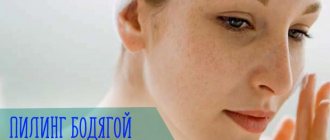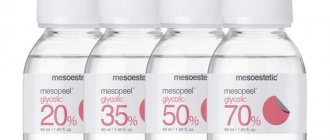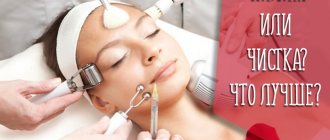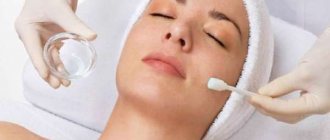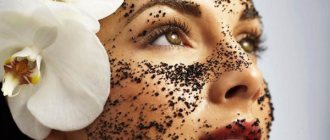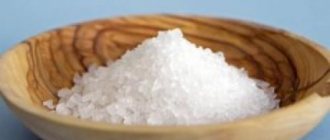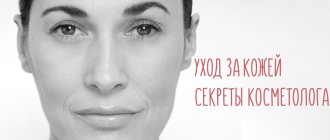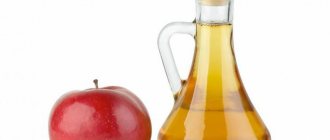Advantages and disadvantages
Jessner peeling, like any other cosmetic procedure, has positive and negative sides. The advantages include:
- safety;
- anti-inflammatory effect without complications;
- deep cleansing;
- can be used at any age;
- noticeable effect even after one session;
- when the skin peels, a person is not limited in his capabilities, so he can perform his usual work;
- short rehabilitation period;
- wide range of indications;
- acceptable price;
- takes no more than 20 minutes.
Jessner facial peeling is used only if the client is aware of the following disadvantages and limitations:
- contraindications (list above);
- the risk of complications remains;
- severe peeling when using a deep cleaning composition;
- unpleasant odor;
- As the number of layers increases, the duration of rehabilitation also changes in direct proportion.
Indications and contraindications
Chemical peels are useful in many cases. The combined composition is used for cosmetic and medicinal purposes. The procedure is required if:
- Wrinkles;
- Pigmentation;
- Skin defects (scars, scars);
- Eels;
- Fading skin.
The principle of renewing the epidermis with the help of substances that cause superficial burns of the skin significantly smoothes it out. If there is scarring on the skin, a course of several treatments will likely be needed. It is advisable to start it at the end of autumn. Among the contraindications:
- Inflammation in the active stage;
- Chronic infection;
- Postoperative period;
- Some diseases of the endocrine system;
- Pregnancy;
- Treatment with systemic retinoids;
- Skin damage;
- Herpes.
To get results, you must listen to the recommendations of cosmetologists.
Advantages of the technique
The Jessner method is absolutely safe. It does not cause complications because the solution does not penetrate into the deep layers of the skin. The epithelium sloughs off quickly and does not cause pain. Uniform exfoliation improves skin condition across the entire surface of the face. Already on the day of the procedure, you can feel the lifting effect of the procedure. Tight facial features bring pleasure and joy to any person.
Peeling can be recommended at any age and on any part of the body. In a short time, cosmetic defects that have been bothering you for years become invisible. By getting rid of scars, many people gain peace of mind and confidence. The session lasts several minutes. There is absolutely no need to take unplanned vacation. It is enough to coordinate with a specialist so that the most active days of peeling occur on weekends. You can also look great by getting rid of excess fat.
Chemical peeling solves many problems and requires little time. This is an alternative to Botox or lifting. The lack of global preparation and a short rehabilitation period allow you to do peeling at any convenient time and quickly return to the normal rhythm of life.
About the author: Larisa Vladimirovna Lukina
Dermatovenerology (Internship in the specialty of dermatovenerology (2003-2004), Certificate of the Department of Dermatovenerology of St. Petersburg State Medical University named after academician I.P. Pavlov dated June 29, 2004); Confirmation of the certificate in the Federal State Institution "SSC Rosmedtekhnologii" (144 hours, 2009) Confirmation of the certificate in the Rost State Medical University of the Ministry of Health of Russia (144 hours, 2014); approved clinical protocols. Read more about me in the Doctors-Authors section.
Compound
The peeling product contains 3 active substances - resorcinol, lactic and salicylic acids in a concentration of 14%. They are selected in such a way as to simultaneously exfoliate dead cells, regulate the functioning of the sebaceous glands and stimulate the regeneration of the epidermis.
Salicylic acid is considered one of the most powerful antiseptics that can prevent the spread of infection. Lactic acid makes the skin softer and more elastic by accelerating collagen production. Resorcinol is necessary to enhance the effect of the two previous ingredients. In addition, it is used as a soothing agent that relieves redness. You can find out the indications and contraindications for the use of these substances from the table.
| Peeling component | Indications | Contraindications | Possible side effects |
| Salicylic acid | Rashes on the face, increased oily skin, open and closed comedones, post-acne (spots, shallow scars), hyperpigmentation | Individual intolerance to ethanol, pregnancy and lactation, infectious diseases of the epidermis | Itching and burning, swelling of the skin, temporary redness, burn |
| Lactic acid | Clogged pores, flaking skin, fine lines and wrinkles, loss of firmness and change in complexion, excessive oil production, age after 35 years | Acute herpetic infection, viral diseases (for example, ARVI), pregnancy and lactation, fresh tan, allergic reaction to the main component | Epidermal irritation, burning, itchy rashes and peeling are normal. Severe burns are possible if the solution concentration is incorrectly selected. |
| Resorcinol | Viral and infectious diseases of the skin, acne, impaired cell regeneration, prolonged itching | Intolerance to the component, childbearing and breastfeeding, deep wounds on the face (including burns) | An overdose of the substance can cause serious changes in the body, including dizziness, nausea and vomiting, and rapid pulse |
As you can see from the table, there are a lot of side effects. For this reason, choose a cosmetologist (or home peeling product) carefully.
Is it possible to peel after fillers?
Both peeling and the introduction of fillers into the skin are procedures aimed at improving the quality of the epidermis and, as a result, transforming its appearance.
These two methods have huge differences between each other: the result of the first method of rejuvenation is the cleansing of the surface of the epidermis from dead, keratinized cells, while the meaning of the second method is the saturation of the skin with useful substances and the restoration of functions thanks to the influence from the inside.
Combining these two approaches is a qualitatively new cosmetological idea: its meaning is to help the skin recover after cleansing of dead particles of the dermis through the use of hyaluronic acid-based compounds.
Conversely, timely removal of the no longer needed top layer provides some assistance during the administration of drugs, because it literally opens access to the needed part and shortens the rehabilitation period.
When asked whether it is possible to do peeling after using fillers, cosmetologists express their unequivocal agreement, albeit with some reservations. Thanks to this combination, the effect of the composition based on hyaluronic acid increases many times, that is, such effects as:
- moisturizing the epidermis, the duration of which will be much longer than without peeling;
- activation of cellular functions, among which improved gas exchange (“skin respiration”), accelerated production of collagen native to the body and enhanced restoration of the structure of the components of the integument are especially pronounced;
- facial contouring, which is much more pronounced than if cleansing had not been carried out;
- reduction in the number of aesthetic defects, for example, bright pigment spots, uneven or sallow complexion, heterogeneous structure of the skin.
However, attention should be paid to the fact that this approach, which consists of combining procedures, should be chosen by those women who have crossed the age of 35. This is explained in such a way that the speed of all ongoing processes slows down, including the ability to renew the epidermis, but at the same time the severity of age-related changes increases: wrinkles, folds, less elasticity of the skin
The very reservation of the experts that was mentioned is the rest period between the two approaches to improving the cover: despite the order in which the combination occurs, it is necessary to wait until the epidermis is sufficiently restored after undergoing the first impact in order to carry out the second, not worrying about how painful the side effects will be.
We recommend reading about facial oval correction with fillers. From the article you will learn about the advantages of this method over surgical facial modeling, options for changing the oval of the face with fillers, and care after the procedure.
And here is more information about how to care for your face after fillers.
Question answer
The question-answer block will help dispel the most common doubts associated with carrying out this cleaning at home.
- How many procedures are needed?
It’s different for different skins. For delicate and sensitive skin, sometimes 5-6 procedures are enough. For oily and problem skin, you will need all 10. If you are doing a mid-Jessner peel, the course will be shorter, as you will achieve results faster.
- How to apply?
Layer by layer: each layer after 5-10 minutes. Sequence: forehead, temples, chin, neck, cheeks, nose.
- How often can I do it?
Average - once every 1.5-2 months. Superficial - every 10 days.
- How to wash it off?
Either using a special neutralizer, which can come in the same kit with the main solution, or using regular warm water, but without foams and gels.
- How to care for your skin?
It is better to purchase a set of post-peel care products along with the peeling solution. Different brands offer both cleansing milk and restorative creams. If for some reason this is not available to you (expensive or not found), the best option is any wound healing cream (for example, Panthenol).
- Why doesn't my skin peel off after peeling?
For the rehabilitation period after a Jessner peel, this is not a completely normal reaction. There may be two reasons. First, you haven’t used chemical exfoliation for a long time (or never before). Accordingly, a too thick layer of keratinized cells has accumulated on the face, which requires more than one procedure and will begin to peel off only after 3 or 4. The second reason is that the cleaning was done too superficially: the solution was applied in too thin a layer or was washed off in a hurry. Try increasing these settings next time.
- When to do it?
It is recommended in autumn and winter, since in spring and summer, under the influence of active sunlight, large pigment spots can form on the face, which will subsequently be very difficult to remove.
Jessner peeling: preparation of the epidermis and procedure
Cleansing the epidermis with a three-component composition involves three stages: preparation, peeling itself, and rehabilitation. The preparatory and final stages of the manipulation can be carried out at home.
Pre-peeling preparation
To prepare for serious effects on the skin, a specialist may prescribe 2-3 sessions of superficial peeling. These can be homemade recipes for compositions of fruit acids or ready-made mixtures that are sold in pharmacies. The use of sunscreen and a special lotion is mandatory. At the same stage, a test is carried out to determine the tolerability of the components of the composition and the absence of allergies. The specialist is obliged to examine and interview the patient in order to identify contraindications.
Peeling with Jessner's composition
The use of moisturizing creams and products based on fruit acids on the day of the procedure is prohibited. First of all, the surface of the face is cleaned with a special composition whose acidity is in the range of 4.5-5.5. Soap cannot be used! Next comes degreasing the skin. The next step is applying the cleaning composition. First, the forehead and temples are processed, then the chin, cheeks, nose, and finally the eyelids. For the patient, Jessner's peeling is accompanied by a burning sensation, this indicates the activity of the components. 2-3 minutes after applying the product, the epidermis should be covered with a white coating - these are crystals of salicylic acid. Using them it is easy to determine the uniformity of application of the composition.
Depending on the skin type, the desired result and the severity of the problems, apply from 1 to 4 layers of peeling base, the time between layers is on average 5 minutes. After each layer, the specialist has the opportunity to assess the depth of penetration of substances and adjust the procedure.
At the end of the manipulation, a soothing mask and moisturizer are applied to the epidermis, on top of the peeling base. The composition itself is washed off by the patient 4-5 hours after its application, at home. If during the procedure there is an undesirable reaction from the skin, the mass is washed off and the session is stopped.
Rehabilitation and recovery period
The intensity of the reaction depends on the number of layers of the composition applied. A few hours after the procedure, most often the next day, slight swelling and redness of the epidermis may appear. The next 2-3 days are marked by the removal of scales, slight peeling, after which the skin will become smooth, even, the pores will narrow, and the oiliness of the surface of the face will decrease.
If a multi-layer Jessner peel was performed, the skin reaction will be more pronounced. Redness may be accompanied by a burning sensation and tightness. Small white areas may appear. A day after the procedure, a thin film forms on the surface of the face, which will disappear on its own within 3-4 days. You should not try to remove it forcibly; pink areas of the epidermis will be exposed, giving your face an unhealthy appearance. If the natural process of discharge is not interfered with, then after the specified time the skin will be renewed and get rid of spots, unevenness and wrinkles.
To obtain a lasting, long-lasting effect, cosmetologists usually prescribe a course of 6-7 procedures, between which there should be an interval of at least 3-5 weeks. The first session is the most gentle, then the number of layers can be increased. After peeling, you should avoid visiting the solarium for at least a month.
The exfoliation process can be facilitated by washing your face daily with acidified boiled water, then applying panthenol ointment. Occasionally you can spray your skin with thermal water. During the rehabilitation period, applying makeup to the face is prohibited.
The result of peeling appears after 7-10 days and lasts up to six months.
A Jessner Peel should be a scheduled procedure with a specific amount of time allotted to it. The rehabilitation period plays a very important role and should be carried out in accordance with the instructions of a specialist.
How does the procedure work?
Before peeling, some specialists perform a superficial peel with a reduced acid content (for example, almond peel). This will help predict how your skin will react to stronger treatments. After that, after at least 10 days, they begin Jessner peeling.
First, the skin is cleansed of makeup and dirt. Afterwards, a layer of acidic preparation is applied to the face, wait up to 5 minutes, and then wash off the layer, which causes the most unpleasant sensations. If a more pronounced effect is required, the product is applied again up to 4 times. Many patients note a pungent alcohol odor from acids, which is normal.
After some time, the chemical mixture is washed off with water and a healing ointment is applied. Somewhere it’s Panthenol and analogues, somewhere it’s regular baby cream. Sometimes the specialist sends the patient home with facial peeling. In this case, after about 6 hours, you need to wash off the acids yourself with water without cleansing cosmetics.
You can watch the video, which breaks down the main aspects of the Jessner peeling in the salon.
What you need to know
The components combine perfectly with each other and promote deep cleansing of the skin. The result can be seen quickly, as dead cells are removed from the epidermis. Additionally, the process of activating the production of collagen fibers is started.
This type of peeling was first described by Max Jessner. The composition was planned to be used as an antiseptic on the ship. The components should have
Chemical components help cleanse the skin. The naked eye can see an improvement in her general condition. A person becomes younger after each course. The Jessner peel contains resorcinol, salicylic and lactic acids.
Types of Jessner peels
Cosmetology knows several options for Jessner peeling. The choice of procedure depends on the complexity and severity of the skin problem, the age of the patient and the required depth of penetration into the skin of the product used. There are superficial and medium Jessner peels.
Superficial peeling is aimed at improving the condition of the skin, normalizing the functioning of the sebaceous glands, smoothing out fine wrinkles and shallow uneven terrain. After the procedure, the face looks refreshed and glows with health. The recovery period after such cleansing is short, only 3-4 days, and may be accompanied by slight peeling. The Jessner Superficial Facial Peel can be used as a preparation for more complex cosmetic procedures. It is recommended to carry out such cleansing before deep peeling or plastic surgery.
Medium peeling provides a more in-depth effect on the skin, and the result is therefore more pronounced. It is recommended to carry out this type of cleansing to eliminate medium-depth wrinkles, scars and scars, post-acne, to discolor pigment spots on the face and combat problematic acne. Rehabilitation after Hollywood medium peeling will last up to 7 days. Unlike superficial cleaning, peeling will be intense and pronounced.
Some cosmetologists, trying to achieve even greater results, offer clients deep Jessner peeling with up to 5 layers of product. After such exposure, a strong dilation of blood vessels is observed, the face becomes covered with crusts, and rehabilitation is quite difficult. The peeling of the resulting crusts will last up to two weeks.
How many procedures are needed and how often can they be done?
For visible, but small results from Jessner peeling, one procedure is enough. However, after completing a course of 5-8 peels, the deepest forms of pigmentation and wrinkles are eliminated. The procedure can be repeated only after complete restoration of the skin!
The frequency of Jessner peels depends on the client’s age (the younger he is, the faster the tissue is restored, which means it is possible to exfoliate the skin more often). The average interval between peels is from 10 days to 2 weeks.
How is a Jessner peel performed in a salon?
Jessner peeling is a procedure that involves applying a mixture of acids to the skin to effectively remove dead skin cells from the epidermis. The method is named after its inventor - a doctor who did not strive to create a peeling product, but pursued the goal of inventing an antiseptic composition for sailors. You can also find another name for this procedure – Hollywood. This is due to her popularity among world-class stars.
The product applied to the skin contains three components - lactic acid (14% concentration), salicylic acid and resorcinol in a similar concentration. These are the classic parameters of the ingredients; they can be changed by a specialist based on the condition of the client’s skin and the required activity of exposure. Since the procedure is essentially a controlled chemical burn, it is recommended that it only be performed by a qualified technician.
Jessner peeling involves the following algorithm of actions:
- The first step is to check for an allergic reaction. To do this, the composition is applied in a small amount to the area behind the ear, and after a day the result is assessed - if no negative changes are observed, then you can resort to the procedure;
- the cosmetologist evaluates the condition of the skin and its main characteristics, selecting the proportions of ingredients based on the information received;
- the preparatory stage involves cleansing the facial skin of excess sebum and cosmetic residues; a clean face is treated with a degreasing agent, and after it dries, a peeling mixture is applied after a couple of minutes; if the skin is thin and sensitive, then use cotton pads, and if oily, then use gauze tampons;
- a layer of product is on the skin for 30 to 120 seconds, after which it is neutralized with a special composition;
- the number of successively applied layers depends on the aggressiveness of the procedure. So for surface cleansing only one layer is required, for middle cleansing – 2, and for deep cleansing – 3-4. The interval between application of layers should not exceed five minutes;
- After each layer, the specialist assesses the condition of the skin - it should turn slightly red. The formed white coating is removed with a napkin - this is formed by one of the components;
- During peeling, a person experiences a slight burning sensation - this is a normal skin reaction;
- At the end of the procedure, the cosmetologist applies a special soothing mask to the skin.
This type of chemical peeling has many advantages:
- a small number of possible side effects;
- can be used on any part of the body and at any age;
- the rehabilitation period after the procedure is minimal;
- it is possible to control the depth of exposure of the product;
- allows you to noticeably tighten skin that has lost its elasticity in just a few procedures. The first effect is noticeable already on the day of “acquaintance” with the procedure.
Recovery
After washing off the peeling agent, the recovery stage begins, during which it is necessary to carefully care for the face. In order for the discomfort after acid exposure to disappear faster and the skin to recover easily, you must follow the rules of post-treatment care:
- do not wash your face for the first 24 hours;
- for the first 5 days do not use skincare and decorative cosmetics (moisturizers are allowed);
- for 2 weeks, avoid prolonged exposure to the sun; when going outside, use cream with a UV filter;
- do not peel off the resulting crust (it should come off on its own);
- do not massage your face;
- do not go to the bathhouse, solarium, or swimming pool for 2 months;
- do not engage in intense sports training that causes sweating;
- to speed up regeneration, use pharmaceutical preparations Bepanten, D-Panthenol, treat the skin with them 5 times a day;
- 3 days after the procedure, to eliminate peeling, use preparations based on cosmetic oils, wax, retinol, panthenol, and plant extracts.
Who is this procedure indicated for?
Jessner's facial peeling, the photo of the results of which you see in this article, has its own indications. This type of exfoliation is recommended if you have the following skin problems:
- Increased pigment production due to various reasons;
- Excessive secretion of the sebaceous glands;
- Skin defects in the form of stretch marks, scars, unevenness;
- Manifestations of acne: inflammation, comedones, blackheads;
- Age-related skin changes: wrinkles, uneven texture, complexion;
- Seborrhea;
- Increased keratosis;
- Ingrown hairs;
- Enlarged pores;
- Dull, uneven complexion.
The indications for the use of Jessner peeling are quite extensive, which is why this procedure is very popular among beauty salon clients. It is worth noting that Jessner exfoliation solves facial skin problems for women of various age groups. This type of exfoliation helps young girls cope with acne, middle-aged women - eliminate fine wrinkles and improve complexion, and ladies of “elegant age” - fight serious age-related changes in the dermis.
It is worth noting that this type of exfoliation can be used even on sensitive skin, if you reduce the number of applied layers to 1. Jessner Martinex home peeling is in great demand. The protocol for using exfoliation at home is simple, and its cost is close to the course of corresponding salon procedures.
Useful tips
To ensure that Jessner's peeling pleases and not disappoints, when doing it at home, take advice from professionals.
- Carefully study the instructions for use of the purchased drugs and follow them exactly.
- Recommended time: autumn and winter.
- When applying Jessner's composition in layers, evaluate the condition of the skin after each application. Listen to the sensations (burning, itching, pain) and look in the mirror (redness): all accompanying symptoms should be moderate. If the skin begins to itch unbearably and becomes covered in blisters, there is no need to fanatically finish the job.
- It will be possible to repeat the procedure only after 1.5-2 months if it is a medium peeling. If superficial - after 1-2 weeks.
- The course consists of an average of 10 procedures, although this figure is determined individually, depending on the condition of the skin.
- If stored for a long time or improperly, Jessner's solution becomes not only useless, but also dangerous. The jar should be kept in a cool place. Screw the lid tightly after each use.

